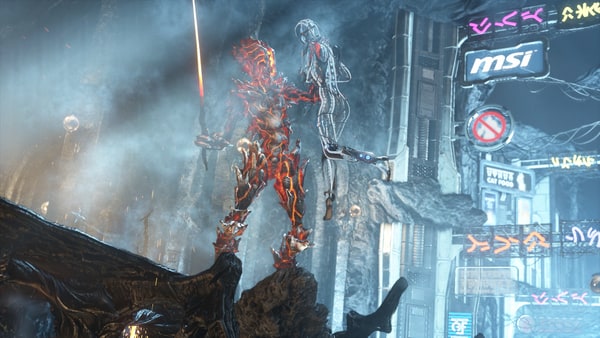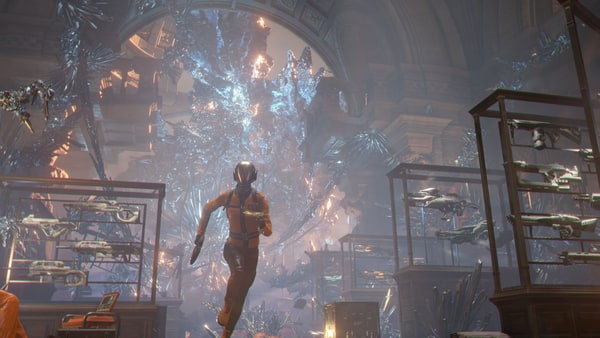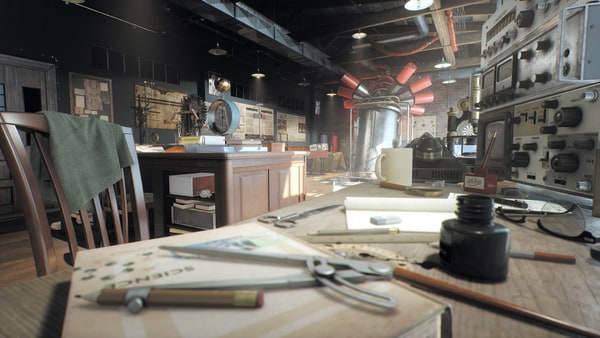Performance of the Razer Blade 15 (2018)
I compare the newcomer's performance to my previous laptop and a high-end gaming desktop.
After my Bachelor’s degree, I decided it was time to replace my old laptop with something more modern and lightweight. The 4.5 kg XMG P704 was becoming a hassle when traveling.
Before diving into the details, let’s take a look at my outgoing XMG. Aside from its hefty weight, it started to feel a bit dated. It barely ran the games I developed during my studies, so there’s definitely room for improvement.
The Old Hardware
XMG P704 PRO (2014)
- Intel Core i7 4710MQ
- Nvidia GeForce GTX 870M (6GB)
- 2x8GB Crucial Ballistix Sport DDR3-1600
- 2x SATA SSDs (1x 250GB, 1x 120GB)
- 17.3” Full-HD TN screen (60Hz)
- 230-watt power supply
Based on the Clevo P177SM-A, the XMG offered solid performance at a reasonable price (~€1670). It featured good I/O and performance comparable to high-end 2011 hardware, with a decent thermal solution. Then Nvidia’s 10-series GPUs shook up the market by bringing laptop GPUs somewhat in line with their desktop counterparts, differing only in memory, clock speeds, and thermals, which resulted in a significant performance boost.
The XMG served me well during my studies, but struggled with projects like And Now and Tea Shop. The 6GB of video memory delayed the aging of the GTX 870M a little. With some overclocking, and later undervolting, I managed to squeeze out 90MHz more clock speed, but Nvidia’s Kepler chips weren’t great for overclocking, especially with air cooling. Laptops also got lesser GPU chips compared to their desktop counterparts due to power constraints.
Unfortunately for me, just a month after I purchased the P704, XMG released the P705, with M.2 NVMe slots and an IPS display. I guess I jumped the gun.
The New Hardware
The Candidates
I considered the following new laptops for my upgrade:
- MSI GS65 Stealth Thin - €2199 (Notebookcheck’s review)
- Gigabyte Aero 15X - €2499 (Notebookcheck’s review)
- Razer Blade 15 (Advanced) - €2449 (Notebookcheck’s review)
- Apple MacBook Pro 15 (2018) - at least €3299 (Notebookcheck’s review)
All four, except the MacBook, shared similar specs: Intel Core i7 8750H, 16GB RAM, Nvidia GeForce GTX 1070 Max-Q, and a 144Hz Full-HD IPS display with 99% sRGB coverage. The MacBook had an i7 8850H, an AMD Radeon Pro 560X (roughly equivalent to the RX560), and a 60Hz Retina Display. Apple planned to include AMD Vega GPUs later, but I failed to see how they’d match Nvidia’s performance in gaming.
All four were light (2-2.5 kg) and premium-priced, but two were eliminated quickly. The MacBook, due to its high price point and weaker graphics, and the MSI for its reportedly poor build quality.
This left the Gigabyte and the Razer. A friend of mine had bought the Gigabyte Aero 15X based on my recommendation and was generally happy with it. I’d still recommend it for solid performance and great battery life. However, the Razer Blade 15 caught my eye just as it was being released. I preferred its sleek, MacBook-like design with a touch of gaming flair, contrasting the Gigabyte with its tacky gamer-y keyboard font. The initial reviews also highlighted the Razer’s strong build quality.
Razer Blade 15
My configuration for €2449 includes:
- Intel Core i7 8750H
- Nvidia GeForce GTX 1070 Max-Q (8GB)
- 2x8GB Samsung M471A1K43CB1-CTD (DDR4-2666 CL19)
- 1x 256GB M.2 PCIe SSD
- 15.6” Full-HD IPS screen (144Hz)
- 230W power supply
Testing Methodology
My goal here isn’t a neutral comparison, but rather seeing how much performance I gained with the new laptop and how it compares to my desktop PC.
The desktop has an Intel Core i7 7700K, 32GB DDR4-3000 CL15 RAM, and an EVGA GeForce GTX 1080Ti SC2. I also tested my old laptop. All three systems were running stable overclocks/undervolts used in daily scenarios.
I tested them in three benchmarks: 3DMark Fire Strike, 3DMark Time Spy, and Unigine Superposition. Due to the differences between the systems, sensor information isn’t equally available, so the data can’t be as detailed as in previous tests. Unfortunately, I couldn’t log the fan speeds on the laptops. However, I still gathered as much useful data as possible. For framerate comparisons I used the framerate output from the respective benchmarking software.
This time, I also logged room temperature during the tests.
Benchmarks
3DMark Fire Strike

Here are the results (average of three runs):
Obviously there’s a significant performance gap between the three systems. The Razer Blade 15 allows the desktop with its GTX 1080Ti a lead of 1.8 times, while itself being 4.5 times faster than the XMG. Thanks to its two extra CPU cores, the i7 8750H in the Blade 15 even edges out the i7 7700K in my desktop in the CPU stress test, which is impressive!
Now, let’s dive into the rest of the data.
The relation core temperature and power consumption of the GPUs is particularly interesting. We’re comparing a GTX 1080Ti (300W power limit), a GTX 1070 Max-Q (90W), and a GTX 870M (100W, although I couldn’t log exact power usage for the latter). All GPUs stay within their power limits, but the undervolted GTX 1080Ti doesn’t fully utilize its limit.
For the desktop, maximum CPU and GPU temps hit 66°C and 68°C respectively, with an average of 35.6W and 192.1W power consumption respectively. The Blade 15 reaches 96°C (CPU) and 66°C (GPU) at an average of 18.7W and 75.3W. The P704 tops out at 73°C and 84°C, with a CPU average of 11.6W.
Obviously, the graphics tests focus more on GPU stress, and CPU tests don’t stress the GPU as much, which is reflected in the average power values. When gaming, the GPU is usually the limiting factor, and that’s the case with these systems in this benchmark, where GPU usage hovers around 100%, while CPU usage is much lower.
3DMark Time Spy

Here are the average results of three runs:
Time Spy, a DirectX 12 benchmark, clearly benefits from modern hardware. The gains are not only from a faster GPU but also from optimizations for this API, supported by Nvidia’s Pascal architecture. The i7 8750H again outperforms the i7 7700K while using less power.
In this test, the GTX 1070 Max-Q delivers 3.7 times the performance of the GTX 870M in the XMG P704, while the GTX 1080Ti in the desktop doubles the performance of the Blade 15. The GTX 1080Ti shows a massive 6.88x performance boost over the GTX 870M — an impressive result.
Here’s the rest of the data:
One issue stands out: while the Blade 15’s GPU temps are manageable, its CPU runs too hot. In the longer Time Spy benchmark, the CPU reaches 99°C, clearly thermal throttling and reducing clock speed. Undervolting the Blade 15 could improve performance stability, though I haven’t had time to try that yet.
Also, note the bouncy usage and temps at the beginning and end of each test. This is due to the 3DMark Launcher, which stresses both the CPU and GPU a bit during menu transitions.
Unigine Superposition

Finally, here are the Unigine Superposition benchmark results using the 1080p Medium preset. The average scores of three runs:
And the remaining data:
It’s clear that the Blade 15 is thermally limited. Even under moderate CPU loads, temperatures rise quickly, though the GPU seems to handle heat better - likely due to its larger chip surface. The CPU’s contact with the vapor chamber cooler or the quality of the thermal paste could be factors for its poor thermal performance.
Still, the Blade 15 holds up well despite this issue. While it doesn’t deliver ultra-high-end performance, it appears to be highly efficient. In the Superposition benchmark, it achieves about 76% of the desktop’s performance while consuming far less power.
Conclusion
The Razer Blade 15 is a powerful device in a compact package. There are some concerns about longevity, particularly because of Razer’s wonky track record with batteries. However, after four months with the Blade, and especially after changing the thermal paste, I’m satisfied with its overall performance.